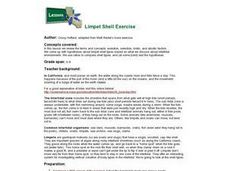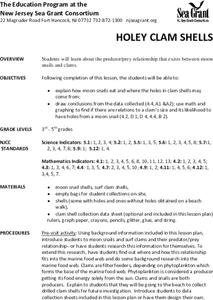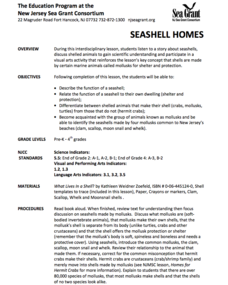Curated OER
Clam Shell Data Collection Sheet
In this clam shell data worksheet, learners collect clam shells and identify their length, width, and if they have holes and not. They indicate the weather, wind direction, tidal stage, surface conditions, and beach conditions at the...
Curated OER
Clam Shell Data Collection Sheet
In this clam shell worksheet, young scholars collect data about 10 clams and measure their length and width. They identify if the clam has a hole or not in its shell and they indicate the location profiled, date, time of day, tidal stage...
Biology Junction
Dissection of the Clam
Is the structure of a clam really as simple as it seems? Young scholars explore the anatomy of the clam in an engaging lesson presentation. The lesson highlights the digestive process of the clam as well as how it moves and what it does...
Howard Hughes Medical Institute
Survival of the Fittest - Variations in the Clam Species Clamys sweetus
It's not often that you come across a clever laboratory activity that is both imaginative and comprehensive! Using M&M's and Reese's peanut butter candies to represent two different clam species, young biologists test for "relative...
Curated OER
Clam Challenge
In this clams learning exercise, students explore clam characteristics. Students complete nine multiple choice questions about clam facts.
Curated OER
Clam Vocabulary
In this clam vocabulary skills worksheet, students match the 9 clam-related terms in the word bank to the appropriate definitions.
Curated OER
Clam Crossword
In this clams crossword puzzle activity, students use the 10 clues and the terms in the word bank to help them correctly complete the word puzzle.
Curated OER
Beach Life: Clam Dissection
Students investigate clams. In this clam life lesson plan, students conduct an experiment where they dissect clams. Students compare anatomies of humans and clams.
Curated OER
Clam-Shell Concentration
Students discuss leisure activities of old Japan. They depict familiar stories or information through symbolic illustrations. Students decide upon game rules and interact in a positive manner while playing the game. They play...
Curated OER
What Lives In A Shell?
Younger students focus on animals and animal habitats in the lower grades. This resource defining habitats focuses on sea animals with shells, but could be augmented to be a richer experience.
Curated OER
Shell
In this paint technique activity, students paint a picture of a clam shell. They draw the clam shell. Students mix red, yellow, and white paint on their drawings. They paint their clam shell with short strokes.
Curated OER
Clam Anatomy
Middle schoolers are introduced to the anatomy of the inside and outside of a clam before dissecting the animal. During the dissection, they label and identify the function of each part they see including the outside of the clam. They...
Biology Junction
Mollusks
Mollusks created every shell on Earth. Young scientists learn more about the phyllum mollusca in an informative presentation. It covers their characteristics, body plans, and relationships in the ecosystem. Then, it details each class of...
Curated OER
Bivalve or Univalve (Clam or Snail)?
Fourth graders explore the meaning of the prefixes "bi" and "uni." In groups, 4th graders observe pictures of shells and handle real shells. Students create a chart to classify each shell as a bivalve or univalve. They identify the...
Curated OER
Limpet Shell Exercise
Students review the terms and concepts: evolution, selection, biotic, and abiotic factors. They come up with hypotheses about limpet shell types based on what we discuss about intertidal environments. Students use ratios to compare...
Curated OER
Oddball Out: Shells
In this problem solving worksheet, young scholars analyze a row of pictures of various shells to determine which creature is different from the others pictured.
Curated OER
Mollusk Matching
Students look carefully at shells and observe the differences between
species and the names of common shells. Then they identify and complete a Mollusk Matching handout included in the lesson plan and write the letter of each shell in...
Curated OER
Holey Clamshells
Students analyze data to make hypotheses and conclusions regarding the predator/prey relationship between moon snail and surf clams.
Carnegie Mellon University
Ocean Acidification
After brainstorming what they know about ocean acidification, youngsters place eggs in acid to determine the effects on calcium-containing organisms, and add carbon dioxide to solutions with sea shell material to discover the impact on pH.
NOAA
Individual Species in the Deep Sea
A tube worm's outer covering is made of chitin, the same material that makes up the shells of lobsters and crabs. Scholars create tube worms and analyze and discuss the longevity of organisms living near cold seeps. They then discuss and...
Curated OER
Comparing and Contrasting
Learners practice compare and contrast skills. In this science and language development lesson, students complete a T chart generating traits of a snail and a clam. Learners complete a related worksheet.
Curated OER
CSI Clamshell Investigation
Students explore predator/prey relationships. They research information on moon snails and claims. Students draw conclusions from the data collected. They use math and graphing to determine if there is a relationship to the clam's size...
Curated OER
Seashell Homes
Pupils listen to a story about seashells. They discuss shelled animals. Learners describe the function of seashell. Pupils relate the function of a seashell to their own dwelling. They differentiate between shelled animals that make...
Curated OER
CSI Clamshell Investigation
Pupils explore and explain how moon snails eat and where the holes in clamshells come from and then draw conclusion from the data collected. They incorporate math and graphing skills to determine if there is a relationship to a clam's...

























